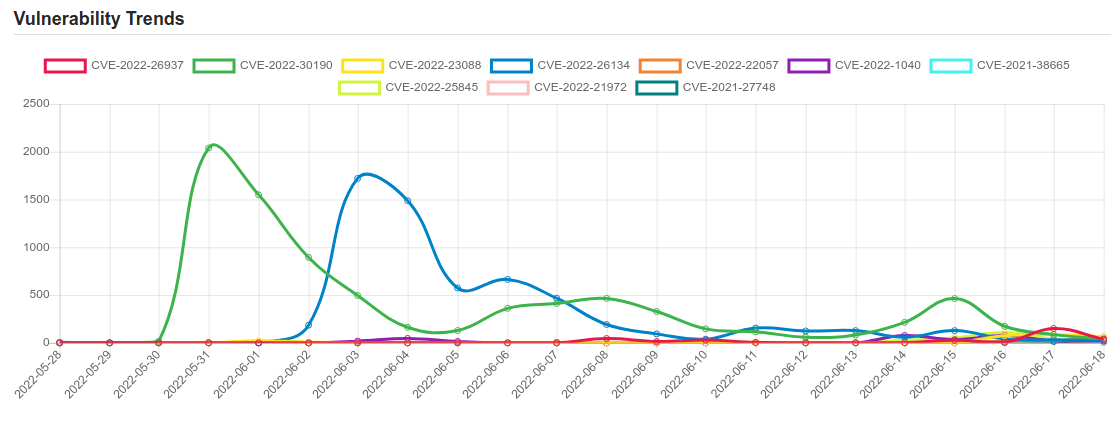Daily Vulnerability Trends: Sun Jun 19 2022

| CVE NAME | CVE Description |
| CVE-2022-21972 | Point-to-Point Tunneling Protocol Remote Code Execution Vulnerability. This CVE ID is unique from CVE-2022-23270. |
| CVE-2021-27748 | No description provided |
| CVE-2022-29455 | DOM-based Reflected Cross-Site Scripting (XSS) vulnerability in Elementor’s Elementor Website Builder plugin <= 3.5.5 versions. |
| CVE-2018-13379 | An Improper Limitation of a Pathname to a Restricted Directory (“Path Traversal”) in Fortinet FortiOS 6.0.0 to 6.0.4, 5.6.3 to 5.6.7 and 5.4.6 to 5.4.12 and FortiProxy 2.0.0, 1.2.0 to 1.2.8, 1.1.0 to 1.1.6, 1.0.0 to 1.0.7 under SSL VPN web portal allows an unauthenticated attacker to download system files via special crafted HTTP resource requests. |
| CVE-2022-32969 | No description provided |
| CVE-2022-27511 | Corruption of the system by a remote, unauthenticated user. The impact of this can include the reset of the administrator password at the next device reboot, allowing an attacker with ssh access to connect with the default administrator credentials after the device has rebooted. |
| CVE-2021-40604 | A Server-Side Request Forgery (SSRF) vulnerability in IPS Community Suite before 4.6.2 allows remote authenticated users to request arbitrary URLs or trigger deserialization via phar protocol when generating class names dynamically. In some cases an exploitation is possible by an unauthenticated user. |
| CVE-2022-32158 | Splunk Enterprise deployment servers in versions before 9.0 let clients deploy forwarder bundles to other deployment clients through the deployment server. An attacker that compromised a Universal Forwarder endpoint could use the vulnerability to execute arbitrary code on all other Universal Forwarder endpoints subscribed to the deployment server. |
| CVE-2022-26757 | A use after free issue was addressed with improved memory management. This issue is fixed in tvOS 15.5, iOS 15.5 and iPadOS 15.5, Security Update 2022-004 Catalina, watchOS 8.6, macOS Big Sur 11.6.6, macOS Monterey 12.4. An application may be able to execute arbitrary code with kernel privileges. |
| CVE-2022-21503 | Vulnerability in the Oracle Cloud Infrastructure product of Oracle Cloud Services. Easily exploitable vulnerability allows high privileged attacker with network access to compromise Oracle Cloud Infrastructure. Successful attacks of this vulnerability can result in unauthorized access to Oracle Cloud Infrastructure accessible data. All affected customers were notified of CVE-2022-21503 by Oracle. CVSS 3.1 Base Score 4.9 (Confidentiality impacts). CVSS Vector: (CVSS:3.1/AV:N/AC:L/PR:H/UI:N/S:U/C:H/I:N/A:N) |
| CVE-2022-32157 | Splunk Enterprise deployment servers in versions before 9.0 allow unauthenticated downloading of forwarder bundles. Remediation requires you to update the deployment server to version 9.0 and Configure authentication for deployment servers and clients (https://docs.splunk.com/Documentation/Splunk/9.0.0/Security/ConfigDSDCAuthEnhancements#Configure_authentication_for_deployment_servers_and_clients). Once enabled, deployment servers can manage only Universal Forwarder versions 9.0 and higher. Though the vulnerability does not directly affect Universal Forwarders, remediation requires updating all Universal Forwarders that the deployment server manages to version 9.0 or higher prior to enabling the remediation. |
| CVE-2022-31289 | https://ossindex.sonatype.org/ Sonatype Nexus Repository Manager OSS 3.37.3-02 is affected by: Incorrect Access Control. The impact is: Authentication Bypass (remote). The component is: Admin Panel. The attack vector is: With the help of response manipulation Attacker can bypass the login panel and view the dashboard menus, No user interaction is required. ¶¶ 1. Go to https://nexus.e-goi.com 2. Click on the Sign In button. 3. Enter the password as admin:admin. 4. Intercept the request in Burp Suite. 5. Capture the Response of the Request. 6. Change the Status Code from 403 Forbidden to 200 OK. 7. You will see the dashboard which provides the admin access. |
| CVE-2022-26937 | Windows Network File System Remote Code Execution Vulnerability. |
| CVE-2022-30190 | Microsoft Windows Support Diagnostic Tool (MSDT) Remote Code Execution Vulnerability. |
| CVE-2022-23088 | No description provided |
| CVE-2022-26134 | In affected versions of Confluence Server and Data Center, an OGNL injection vulnerability exists that would allow an unauthenticated attacker to execute arbitrary code on a Confluence Server or Data Center instance. The affected versions are from 1.3.0 before 7.4.17, from 7.13.0 before 7.13.7, from 7.14.0 before 7.14.3, from 7.15.0 before 7.15.2, from 7.16.0 before 7.16.4, from 7.17.0 before 7.17.4, and from 7.18.0 before 7.18.1. |
| CVE-2022-22057 | Use after free in graphics fence due to a race condition while closing fence file descriptor and destroy graphics timeline simultaneously in Snapdragon Auto, Snapdragon Compute, Snapdragon Connectivity, Snapdragon Industrial IOT, Snapdragon Mobile, Snapdragon Wearables |
| CVE-2022-1040 | An authentication bypass vulnerability in the User Portal and Webadmin allows a remote attacker to execute code in Sophos Firewall version v18.5 MR3 and older. |
| CVE-2021-38665 | Remote Desktop Protocol Client Information Disclosure Vulnerability |
| CVE-2022-25845 | The package com.alibaba:fastjson before 1.2.83 are vulnerable to Deserialization of Untrusted Data by bypassing the default autoType shutdown restrictions, which is possible under certain conditions. Exploiting this vulnerability allows attacking remote servers. Workaround: If upgrading is not possible, you can enable [safeMode](https://github.com/alibaba/fastjson/wiki/fastjson_safemode). |
If you like the site, please consider joining the telegram channel and supporting us on Patreon using the button below.


![[QILIN] - Ransomware Victim: Culver's Lawn & Landscape, Inc[.] 3 image](https://www.redpacketsecurity.com/wp-content/uploads/2024/09/image-300x300.png)

